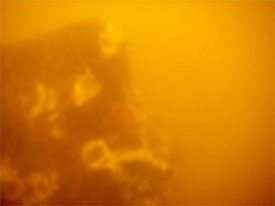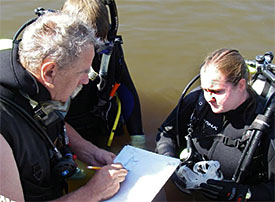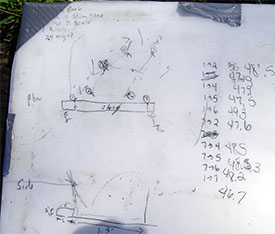
East Carolina University 2007 Field School
in Underwater Archaeology
24 May 2007
By Steve Dilk
As I rode back from the Washington Park site with our Dive Safety Officer (DSO) Mark, I was awoken from the exhausted and often mindless day dream that befalls the mind after a day full of challenging physical and mental activity by a sardonic comment from Mark, who was basically voicing his hopes that the gentleman ahead would drive s l o w e r than he already was. I thought to myself that the man in front was probably just slowly driving home after a pretty average day at work. Thinking this, I compared what I thought his experiences were to what I had just experienced. As an undergraduate from the University of Rochester, much of what I have done in the past few weeks has been completely novel. Today was no exception.

A view of the Washington Park vessel's sternpost as seen through the less than clear water of the Pamlico River.
I enrolled in this field school because I have been interested in archaeology for a very long time. As such, I have already participated in a number of terrestrial field schools. But, after I had taken a class about comparative colonization of the Greeks and Europeans, which included in it many underwater archaeological investigations, I decided that I wanted to try my hand at underwater archeology as well. Fast forward a year and a few months and I find myself in sunny (and tropical by Rochester standards) Greenville, North Carolina.

Dr. Larry Babits confers with students Steve Dilk and Mel Ashmore about recording the stern area.
I approached this field school with an unusual mixture of trepidation, curiosity and rabid excitement. I knew that I was entering this project as the one with the least amount of experience, knowledge, and years, therefore relegating myself to the weakest part of the project team. It is not in my nature to regard myself in such a position so as the field school approached I found myself anxiously awaiting the chance to really get in the field and learn and help out as much as I could. This objective is not hard to accomplish in this field school.
Today was a very exciting day on site. Before I go into detail it would be dishonest of me not to put a disclaimer about the phrase “exciting day” before I start writing about my personal experiences and the generalizations I make about the group and its overall feelings, because as could be easily assumed, each day brings something brand new for me to learn, see and try. As such I will probably always write that the day was exciting and may tend to over-generalize that feeling when, for those of us who have had more experience in the field, it may not seem that way.

Dr. Stewart and Jeremy carefully transport the rudder assemblage to shore.
So, what seemed at first glance like a regular day full of dredging at the sternpost plus some goniometer work, soon ballooned into mapping and artifact recovery. After the previous day’s dredging it was noticed that a piece of wood that resembled a tiller or rudder lay on its side in the portside area that had been dredged. Mel and I, with the help of our crew chief Adam, were given the task of recording data points and doing some preliminary mapping of the mystery piece and then to bring it up. I went down with the tape and together, Mel and I recorded five points around the object. After we had accomplished this we then retrieved a piece of plywood to lay the piece onto when it was brought to the surface. Then, Mel and I took the plunge and together brought the piece up to surface. Dr. Stewart and Jeremy assisted us as well.

Steve and Mel's slate with the data they recorded on the sternpost.
Afterwards, Mel and I also had to create a plan and profile view of the port side sternpost assemblage. The afternoon wind had started to pick up which brought with it some sizeable waves. Consequently, we devised a plan where I would go down and measure while Mel stayed on the surface and recorded the numbers. With some helpful advice from Calvin we were able to get those measurements done. They included the length and width of the sternpost, along with other parts of the assembly.
This day marked a few firsts for the team and myself. We accomplished a good deal and were treated with the news that we had made the front page of the local Washington Daily newspaper. I conclude by saying that I certainly feel privileged to be a part of this team. I am totally immersed in an environment full of knowledgeable people, learning opportunities, good weather, and of course water too.
Please feel free to contact us at mua@keimaps.com with any comments, questions, or suggestions during the weeks to come.
Return to Project Journal home page.

